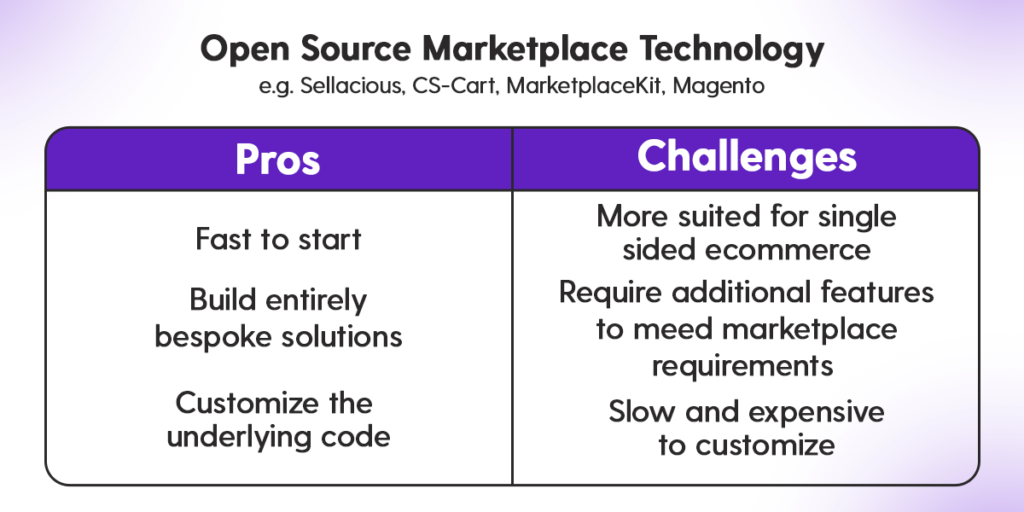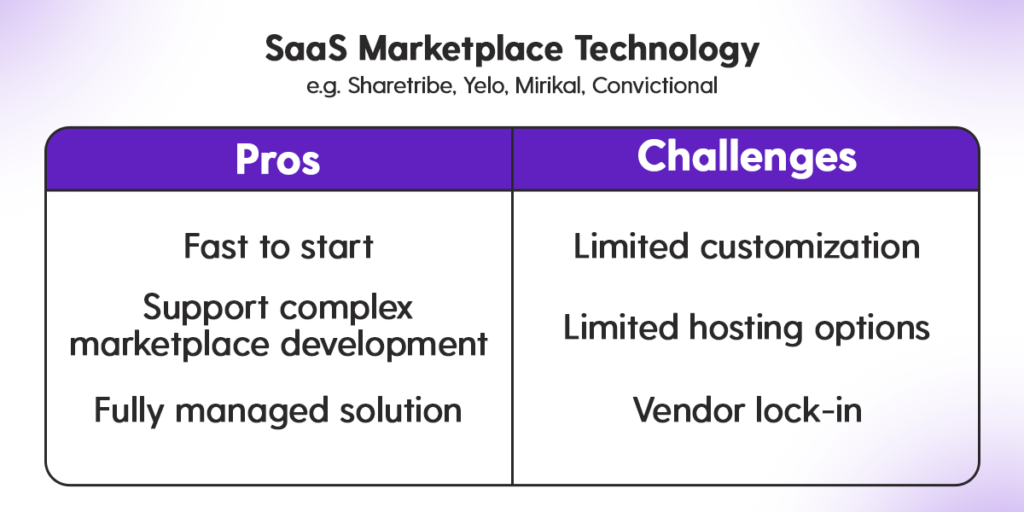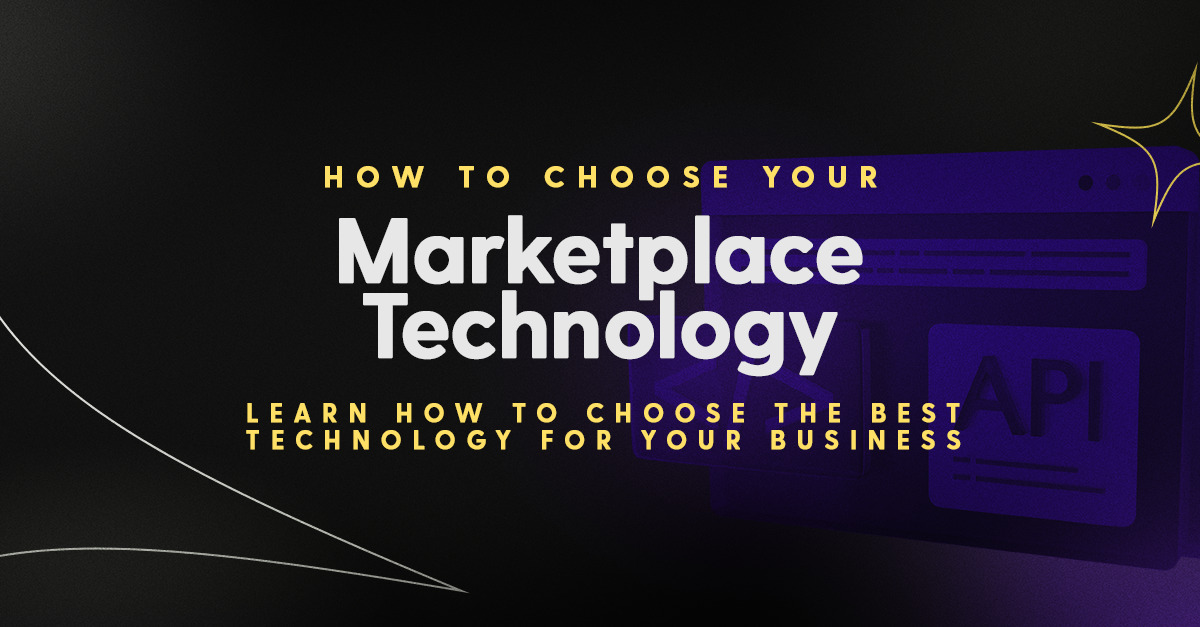Statistics show that online marketplace businesses are becoming increasingly popular.
In 2021, marketplaces accounted for 67% of global ecommerce business, with the top 100 marketplaces generating over $3.2 trillion in revenue (Digital Commerce 360 Community).
But with so many marketplace technology options available, it’s challenging to decide which approach works best. Should you choose a marketplace open source solution, a traditional SaaS marketplace platform, or something else entirely?
Traditionally, marketplace founders and operators needed to code their marketplaces from scratch.
Coding a marketplace from scratch is however slow and expensive.
As such, specialized marketplace technologies were developed to help users quickly configure online, multi-vendor marketplaces.
This guide will help you:
– Understand what marketplace technology is.
– Compare marketplace open source vs. SaaS marketplace solutions.
– Choose the best technology for your business.
What is marketplace technology?
Marketplace technology, also known as marketplace software, refers to the tools and platforms designed to build and operate online marketplaces. Whether you’re creating a multi-vendor platform, a peer-to-peer marketplace, or a B2B marketplace, choosing the right technology is crucial.
Marketplace software is useful because it allows you to jumpstart your marketplace development by using a prebuilt marketplace solution that you simply need to configure for your specific use case.
Popular Marketplace Technologies Include:
– Dittofi (Hybrid No-Code Marketplace Builder)
– CS-Cart (Marketplace Open Source Solution)
– MarketplaceKit (Flexible Open Source Platform)
– Sharetribe (SaaS Marketplace Solution)
Open source vs SaaS solutions
When building your online marketplace, you generally have two main options: marketplace open source software or SaaS (Software as a Service) solutions. Let’s break down the pros and cons.
- Marketplace Open Source Technology (The Flexible Choice)
Open source marketplace software refers to platforms or solutions where the source code is freely available for anyone to view, modify, and distribute. In the context of online marketplaces, open source solutions offer a set of pre-coded features. In addition, these systems give you access to the marketplace source code for heavy duty customization to meet specific business requirements.
Examples: MarketplaceKit, CS-Cart, Magento.
Best For: Businesses looking to build bespoke marketplace solutions with maximum flexibility.
- SaaS Marketplace Technology (The Fast-Track Choice)
In contrast, SaaS (or Software as a Service) marketplace technology refers to hosted solutions. In this model, the marketplace platform is provided as a service. In the SaaS model, businesses subscribe to the platform and access its features and functionalities through a web browser, without needing to manage the underlying infrastructure or source code.
SaaS marketplace software tends to be easier to set up and maintain; however, these solutions are limited in terms of flexibility and customization options. This is since they do not allow you to modify the underlying source code for your marketplace.
Examples: Sharetribe, Arcadier, Dittofi (Hybrid No-Code).
Best For: Founders who want to launch fast with minimal technical expertise.
Hybrid No-Code Marketplace Technology (Best of Both Worlds)
Hybrid no-code platforms like Dittofi combine the speed of SaaS solutions with the flexibility of marketplace open source platforms.
How It Works:
Build and launch your marketplace with no coding required.
Export the open source code anytime for full control.
Deploy on your own hosting or Dittofi’s managed cloud.
Pros and cons of using marketplace technology
Your choice of which marketplace technology to use ultimately boils down to your available technical skills, the need you have for code customization, your marketplace domain and the time or budget that you have to build a two sided, multi vendor marketplace.
Pros and challenges of using open source marketplace technology
In this section, we look at the pros and challenges of using open source marketplace technology.

Pros of open source
The main pros of using an open source marketplace software is that you can jumpstart your marketplace development with all the essential features required by a marketplace.
You can then extend your marketplace with complete flexibility, allowing you to develop a unique and entirely bespoke marketplace solution. In this setup, the source code provides all of the technical scaffolding. The source code can then be edited in order to support business needs.
Challenges with open source
Most open source marketplace technologies were originally developed as single sided ecommerce stores. This means that, whilst they provide a large amount of functionality out of the box, they often require additional features and configuration to meet the specific marketplace business model. The need for additional features can rapidly expand the scope of development and this can lead to the need to purchase additional plugins or higher expensive engineering talent.
All in all, this means that open source marketplace technology is best suited for users who want to be able to modify and customize the source code for their marketplace, so that they can create the experiences they need. However, the cost and effort of development is higher than using a SaaS marketplace technology (as we are about to see).
Pros and challenges of using SaaS marketplace technology
In this section we will look at the pros and challenges of SaaS marketplace technology. We also make mention of where hybrid no code marketplace builders can overcome challenges with traditional marketplace SaaS solutions.

Pros of SaaS
In contrast to open source marketplace technology, traditional SaaS marketplace technologies are specifically designed to meet the complex needs of two-sided, multi-vendor marketplaces. These solutions deliver core functionality with only very small amounts of customization required. Often customization can be done by simply filling out forms to set custom colours, add logos, update copywriting and so on. This makes them ideal for teams with fewer technical resources at their disposal.
In addition, SaaS solutions come with automatic hosting which is maintained by the provider. This gives teams the lowest path of resistance when thinking about platform deployment, updates, security, support, QA and devops.
Beyond this, the major advantage of SaaS is that they provide a streamlined model for success. This includes marketplace training materials, well tested user experiences, developer support and tiered subscription models that aim to grow with your business.
Challenges of SaaS
The challenges of traditional SaaS are that, whilst you can get up and running quickly and with limited technical assistance required, you will quickly run into platform limitations. To get around limitations, you will need to employ developers who will build customizations on top of the SaaS. These customization are limited to the general structure and technology choices of the SaaS. So, whilst you don’t have to worry about building your marketplace from scratch, you will not ever own the core marketplace technology or the decisions made around the marketplace development.
In addition to platform limitations and vendor lock-in, you are also dependent on the SaaS hosting model. This means that you cannot take advantage of new cloud technologies that can are essential to improve the performance, resilience, security and cost effectiveness of running a marketplace at scale.
Hybrid no-code marketplace technology
More modern hybrid no code marketplace technologies such as Dittofi were developed to get around the challenges with SaaS marketplace technology.
For example, Dittofi provides a no code marketplace builder, which offers a SaaS experience developed on top of a no code platform. This solution allows you to quickly and easily build, launch and customize the Dittofi marketplace technology without coding and without limits. Dittofi then transforms visual designs into quality, open source code, that you can either export and pass off to developers or deploy in one click into fully managed hosting or into your own hosting environments.
With this model, you are able to get the best of both worlds. The speed and cost effectiveness of SaaS, but with the flexibility and code control of open source.
To further add to this, Dittofi generates quality code on a modern tech stack (React and Google Go), giving you a solution that is equivalent to hiring the best engineering teams in the world.
Conclusion: how to choose your marketplace technology?
Multi vendor marketplaces are complex to implement when compared to traditional, single sided e-commerce stores. However, specialist marketplace software can make the development of a marketplace significantly easier.
Choosing between marketplace open source software and SaaS marketplace solutions depends on your budget, timeline, and customization needs. Open source marketplace technology allows for bespoke marketplace development but is more expensive and complex to set up compared to SaaS marketplace technologies. Open source is therefore better suited for companies who want to handle every aspect of their product development and are not in a rush to enter the market.
In contrast, SaaS solutions require less technical skills to set up and are faster to get to market. However, they are also heavily limited in terms of what they can develop.
Newer technologies such as Dittofi’s hybrid no code marketplace builder can help to significantly speed up development, keep costs low and allow you to develop bespoke marketplace solutions without having to write any code.
Become a Marketplace Insider
Join our inner circle for exclusive insights, coveted trade secrets, and unparalleled strategies – your journey to marketplace dominance begins here.

